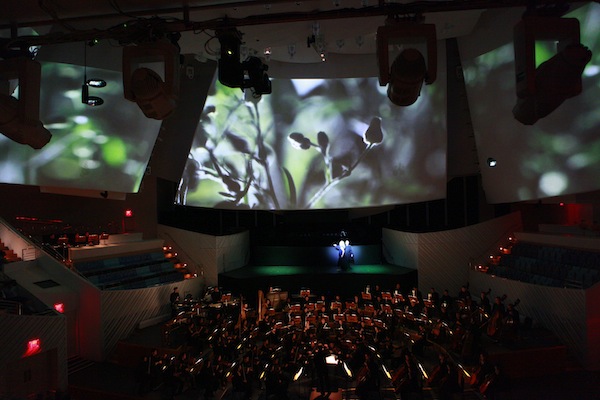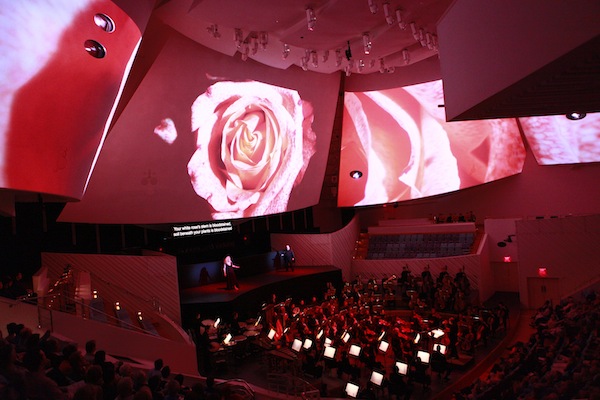
The inexorable embrace of Bluebeard
By Sebastian Spreng, Visual Artist and Classical Music Writer
Last Friday and Saturday, lovers of music and the visual arts were treated to a fascinating interdisciplinary production that showed off the possibilities of Miami Beach’s New World Center and restored the glory of Béla Bartók’s sole, magisterial opera: Duke Bluebeard’s Castle (A kékszakállú herceg vára). It was an event where musical and visual excellence met, thanks to Nick Hillel’s magical projections that were subtle, restrained, never intrusive and always suggestive. Both artistic disciplines transformed Frank Gehry’s space into a multimedia “castle” at the service of music. The doors closed and the audience found itself trapped in an inexorable, spine-chilling embrace within the cryptic Bartókian “Mikrokosmos”. It was an electrifying performance of a musical psychological thriller.
In 1911, captivated by Debussy’s Pelléas et Mélisande, Bartók dove deep into the unconscious carrying his knowledge of Hungarian folklore and Charles Perrault’s Grand-Guignol-like story. As composer Paul Dukas had done in his 1907 Ariane et Barbe-Bleue, Bartók and librettist Béla Balázs drew on Maurice Maeterlinck’s symbolism to craft a singularly original, “unstageable” opera that confuses, frightens and hypnotizes. This Bluebeard, sublimated á la Siegmund Freud, and his latest wife invite us to open the seven doors in the labyrinth of his castle-soul. He is a Minotaur of sorts and she, a curious Pandora, in this case appropriately named Judith. As the valkyrie Brünnhilde is to Wotan, she is his will, his key, his mirror and his alter ego, with the difference that Bartók succeeds in encapsulating in just one hour all the Wagnerian intensity and length.
In the brief prologue, actor George Schiavone warned the audience: “Keep your eyelids open, but…ladies and gentlemen, where are we? Neither outside nor within.” The interpretations are endless. Each audience member will have a non-transferable experience as the certainty that the couple will never find each other, and neither will Bluebeard find himself. A multifaceted musical jewel, and a fable about sacrifice, where the steps through the winding passageways and staircases (reflected in the menacing repetition of the walking bass line) lead to the archives of Bluebeard’s life, to unmentionable secrets and unrepeatable experiences.

During this search for the only key Bluebeard needs to find peace, the music navigates between the conscious and the unconscious, through an icy palace of walls that sigh and weep; through myriad muffled sounds and brilliant tones applied in an asymmetric, strange progression. Judith has left everything behind and given herself to Bluebeard, who envelops, immobilizes, dominates and redeems her. Victim or victimizer, he’s an allegory of time – each of his wives stands for a part of the day, and Judith will be his Queen of the Night, wrapped in a mantle of stars – and for ourselves. Behind every door is his life and ours, dotted with landscapes to which we cannot return and which we cannot change.
Bluebeard’s music emerged gently from the darkness only to return to it after a gradual, stealthy climb towards the solitary ray of light provided by the tremendous C major chord that accompanied the opening of the fifth door. Here, the entire orchestra played C major and the hall seemed to explode in a blinding, dazzling coup-de-théâtre that combined all possible light and sound, bringing to mind Edvard Munch’s “The Scream.” It marked a zenith, an orgasmic escape valve that released unbearable tension and signaled the point of no return initiating a descent back into the abyss by way of the lake fed by tears, accompanied by the swell of harps and celestas.
That searing light – Bluebeard’s realm and soul – disturbed the ominous serenity of the rest of this dreamlike, dizzying music that seemed to reverberate forever. Music that is familiarly uncomfortable, dense and velvety, without apparent handholds; music that stained everything it touched with the color of bull’s blood and virtually blazed thanks to a memorable New World Symphony meticulously conducted by Michael Tilson Thomas. The strings, flutes and oboes stood out, as did the fanfares of trumpets on either side of the stage. Crowning an unforgettable night were two world-class stars: a brilliant, committed Michelle DeYoung as Judith and the towering American bass, Eric Halfvarson, endowed with the most terrifying black voice as Bluebeard.
Bartók found himself in Bluebeard. He found his mature voice and left his virtuosic stamp, confirmed by the vigorous late Sixth Quartet (1939), beautifully performed by four members of the orchestra’s strings in the first part of the program. If Bluebeard was Bartók’s only opera, it was the first – and let us hope – not NWS’s last. Irrefutable proof was the fervor of an audience blown away by this singular rendition of a unique opera. For this “musical event of the season”, bravo to Michael Tilson Thomas and his superb team for making this “unstageable” opera a reality and revealing to us Bartók’s soul, as deep, haunted and solitary as his Bluebeard.
Recent Content
-
Artsarticle ·
-
Artsarticle ·
-
Artsarticle ·
